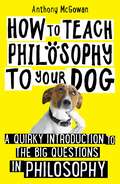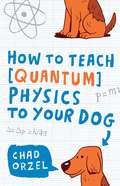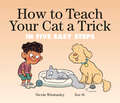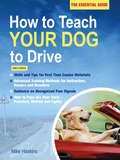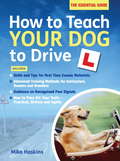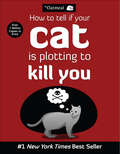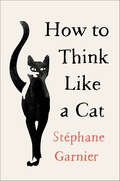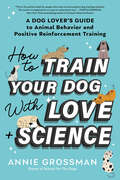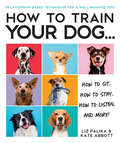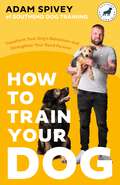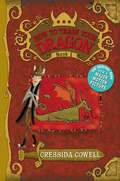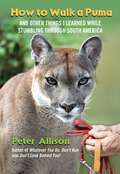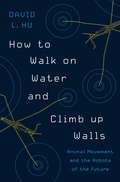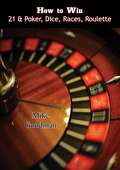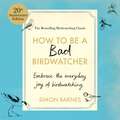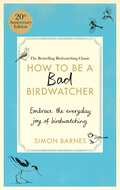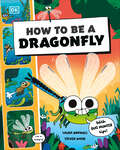- Table View
- List View
How to Teach Philosophy to Your Dog: A Quirky Introduction to the Big Questions in Philosophy
by Anthony McGowanMonty was just like any other dog. A scruffy and irascible Maltese terrier, he enjoyed barking at pugs and sniffing at trees. But after yet another dramatic confrontation with the local Rottweiler, Anthony McGowan realises it&’s high time he and Monty had a chat about what makes him a good or a bad dog. And they don&’t stop at ethics. Taking his cue from Monty&’s canine antics, McGowan leads us on an enlightening jaunt through the world of philosophy. Will Kant convince Monty to stop stealing cheesecake? How long will they put up with Socrates poking holes in every argument? Do they have free will to pursue answers to these questions? Join the dutiful duo as they set out to uncover who – if anyone – has the right end of the ethical stick and can tell us how best to live one&’s life. But there is also a shadow over their conversations. Monty is not well… And so towards the end the biggest questions raise their heads: is there a God? Does life have a meaning? By the time of their last walk together, Monty – and the reader – will find that they have not just solved a few philosophical puzzles, but absorbed much of the history of Western philosophy.
How to Teach Quantum Physics to Your Dog
by Chad OrzelLearn the basics of quantum physics with this clever, fun, and lighthearted introduction to modern physics based on a series of conversations with Chad Orzel and his dog Emmy.When physics professor Chad Orzel went to the pound to adopt a dog, he never imagined Emmy. She wasn’t just a friendly mutt who needed a home. Soon she was trying to use the strange ideas of quantum mechanics for the really important things in her life: chasing critters, getting treats, and going for walks. She peppered Chad with questions: Could she use quantum tunneling to get through the neighbor’s fence and chase bunnies? What about quantum teleportation to catch squirrels before they climb out of reach? Where are all the universes in which Chad drops steak on the floor? With great humor and clarity, Chad Orzel explains to Emmy, and to human readers, just what quantum mechanics is and how it works—and why, although you can’t use it to catch squirrels or eat steak, it’s still bizarre, amazing, and important to every dog and human.
How to Teach Your Cat a Trick: in Five Easy Steps (How to Cat books)
by Nicola WinstanleyIn this hilarious and clever follow-up to How to Give Your Cat a Bath, a boy, a dog and a know-it-all narrator are thwarted by a cat who refuses to learn a trick. The perfect read-aloud for fans of Interrupting Chicken.Step one: Decide on a trickStep two: Get some treats readyStep three: Hold the treat in your hand and ask your cat to do the trickStep four: Watch your cat do exactly what you asked him to doStep five: Reward your cat for doing the trick Simple, right? This spoof on an instruction manual features an increasingly bewildered human, a nonchalant cat, a very good dog and a know-it-all narrator . . . who really doesn't know it all. How DO you teach a cat a trick? Read on to find out!
How to Teach Your Dog to Drive
by Mike HaskinsIs your eyesight failing, are you not very good at driving yourself, or are you simply blind drunk? These are just a few of the reasons why it would make perfect sense to teach your dog to be your new chauffeur.Here, for the first time, is a complete guide: how to get your dog acquainted with the controls, which breeds are the safest drivers, frequently asked questions; and how to get your dog successfully through their tests.Never again need you wait for a taxi, or make that long highway drive unassisted. If you are a dog owner and a car owner, then How to Teach Your Dog to Drive will be the most useful book you buy this year, or even this decade . . .
How to Teach a New Dog Old Tricks: The Sirus Puppy Training Manual
by Ian DunbarVeterinarian and animal behaviorist, Dr. Ian Dunbar is Director of the Center for Applied Animal Behavior, Founder of the Association of Pet Dog Trainers and host of the popular British TV series Dogs With Dunbar. Ian is the author of numerous books and videos including Dog Behavior, Sirius Puppy Training and Dog Training For Children.
How to Teach your Dog to Drive
by Mike HaskinsIs your eyesight failing, are you not very good at driving yourself or are you simply blind drunk? These are just a few of the reasons why it would make perfect sense to teach your dog to be your new chauffeur. Here, for the first time, is a complete guide: how to get your dog acquainted with the controls, which breeds are the safest drivers, frequently asked questions; and how to get your dog successfully through their tests.Never again need you wait for a taxi, or make that long motorway drive unassisted. If you are a dog owner and a car owner, then How to Teach Your Dog to Drive will be the most useful book you buy this year, or even this decade . . .
How to Tell If Your Cat Is Plotting to Kill You
by The OatmealJesus Rollerblading Christ—another helping of TheOatmeal! Mrow, MOAR kitty comics. Mr. Oats delivers a sidesplitting serving of cat humor in his new book, How to Tell If Your Cat Is Plotting to Kill You.If your cat is kneading you, that's not a sign of affection. Your cat is actually checking your internal organs for weakness. If your cat brings you a dead animal, this isn't a gift. It's a warning. How to Tell If Your Cat Is Plotting to Kill You is a hilarious, brilliant offering of comics, facts, and instructional guides about crazy cat behaviors from the creative wonderland at TheOatmeal.com.How to Tell If Your Cat Is Plotting to Kill You presents fan favorites, such as "Cat vs. Internet," "How to Pet a Kitty," and "The Bobcats," plus 17 brand-new, never-before-seen cat-themed comic strips. This Oatmeal collection is a must-have for cat-lovers from Mr. Oats!
How to Think Like a Cat
by Stéphane GarnierLearn the secrets of being calm, cool, and charismatic with this “playful self-help guide . . . sure to please cat lovers” (Publishers Weekly).Do cats worry about retirement? Nope. Do cats do things they don’t want to do? Definitely not. Do cats rush around at all hours of the day when they’d rather be licking their paws and looking out a window? Please.Calm, free, charismatic, wise, elegant, self-assured—our beloved feline pets strut those traits that we humans spend a lifetime aspiring to. No wonder everybody wants to be more like a cat.After observing his own cat, Ziggy, for years, bestselling French author Stéphane Garnier decided he would be much happier if he could just live more like Ziggy. Closer study only confirmed his suspicion that cats have that je ne sais quoi, and he set out to share Ziggy’s innate wisdom with the world.Whether at work, at home, or in your social life, your cat can teach you how to manage stress, cultivate independence, and live life on your terms. Peppered with humorous yet inspiring tips for living a day in the life of a cat, cat secrets from Ziggy, and a quiz to assess your “cat quotient,” How to Think Like a Cat is an inspiring, humorous, and remarkably insightful guide to the subtle art of living like a feline.
How to Think Like a Horse: The Essential Handbook for Understanding Why Horses Do What They Do
by Cherry HillIn this fascinating best seller, Cherry Hill explores the way horses think and how it affects their behavior. Explaining why certain smells and sounds appeal to your horse&’s sensibility and what sets off his sudden movements, Hill stresses how recognizing the thought processes behind your horse&’s actions can help you communicate effectively and develop a trusting relationship based on mutual respect.
How to Train Your Dad
by Gary PaulsenFrom the legendary author of Hatchet, a laugh-out-loud misadventure about a boy, his free-thinking dad, and the puppy-training pamphlet that turns their summer upside down.Twelve-year-old Carl is fed up with his father's single-minded pursuit of an off-the-grid existence. His dad may be brilliant, but dumpster-diving for food, scouring through trash for salvageable junk, and wearing clothes fully sourced from garage sales is getting old. Increasingly worried about what schoolmates and a certain girl at his new school might think of his circumstances—and encouraged by his off-kilter best friend—Carl adopts the principles set forth in a randomly discovered puppy-training pamphlet to “retrain” his dad’s mindset . . . a crackpot experiment that produces some very unintentional results.This is a fierce and funny novel about family, green-living, and untangling some of the ties that bind from middle-grade master Gary Paulsen.
How to Train Your Dog with Love + Science: A Dog Lover's Guide to Animal Behavior and Positive Reinforcement Training
by Annie GrossmanFinally: A dog training book that makes sense—for both dogs and humans—using positive reinforcement techniques based on animal behavioral science.For generations, celebrity trainers have preached that dog owners must "dominate" dogs and have criticized people for daring to treat pets with affection.How To Train Your Dog with Love + Science presents a modern and science-based approach to dog training, showing how behavior can be changed without coercion and force. Annie Grossman, a journalist-turned-dog trainer, breaks down what positive reinforcement actually is and makes the case that "good dog training" may even be a window into understanding ourselves.Grossman offers building-block exercises and tips on how to train effectively using the reward-based methods she's honed over the last decade with clients at her Manhattan training center, School For The Dogs. Whether you've just brought a new dog into your home or you're wanting to teach an old one new tricks, How to Train Your Dog with Love + Science will help you consider what behaviors you want and help you to achieve your goals using techniques rooted in the science of behavior.Woven into this lively how-to guide is the century-long history of positive reinforcement training, from Pavlov's dogs and Skinner's rats to today's apartment-dwelling dogs using Wifi-enabled devices.By employing the easy-to-understand techniques laid out in this book, you will be able to train your dog to live confidently, comfortably, and happily in your world.
How to Train Your Dog: A Relationship-Based Approach for a Well-Behaved Dog
by Liz Palika Kate AbbottBond with your canine friend and learn how to train the dog that's in front of you with relationship-based methods. It's the easiest and most effective way to get happy, noticeable results.Your dog is your faithful friend, and they're happiest when they're by your side. But without some basic training, a dog can turn your life—and your house!—upside down. Chock-full of clear and easy-to-follow training tips and helpful color photos to illustrate, this guide will make you and your dog the best-behaved pair at the dog park! In this book, you get:Simple suggestions on establishing and strengthening your bond with your dog.A look at the collars, leashes, toys, treats, and other teaching tools you need.Terrific tips for keeping your training sessions exciting and upbeat so you both enjoy them.Easy lessons on housetraining and teaching basic commands, like sit, stay, and come.Pointers on using the positive lure-and-reward method to correct problem behaviors.Fun tutorials for teaching your dog tricks, retrieving games, agility, and more!
How to Train Your Dog: Transform Your Dog's Behavior and Strengthen Your Bond Forever A Dog Training Book
by Adam SpiveyEverything you need to know to tackle your dog&’s behavioral issues and understand how your dog thinks, from the trainer behind social media sensation Southend Dog TrainingDo you wish you could get your dog to behave better? Southend Dog Training founder Adam Spivey can help. In this indispensable book, he helps you build a better connection with your dog at any age and solve any behavioral issues with simple, proven training techniques. He won&’t just tell you what to do to get your dog to listen to your commands; he will also help you to understand how your dog thinks and why they might be struggling with certain things. How to Train Your Dog will help you and your dog with• Leash training, recall, and reactivity when you&’re both out and about• Jumping, excessive barking, and reactions to the TV or doorbell• Dos and don&’ts for households with children and/or multiple dogs• Chewing, biting, and destructive behavior Whether your dog is old or young, from a breeder or is a rescue, and has big or small issues, Adam&’s inimitable straight-talking approach will get you to a better place with your best friend.
How to Train Your Dog: Transform Your Dog’s Behaviour and Strengthen Your Bond Forever
by Adam SpiveyDo you wish you could get your dog to behave better?Southend Dog Training founder Adam Spivey can help. In this indispensable book he teaches you all you need to know to build a better connection with your dog and solve any behavioural issues with simple, proven training techniques. He won't just tell you what to do to get your dog to listen to your commands, but will also help you to understand how your dog thinks and why they might be struggling with certain things.Here are just a few of the things How to Train Your Dog will help you with: - Lead training, recall and reactivity when you're out and about - Jumping up, excessive barking and reacting to the TV or doorbell- Do's and don'ts for households with children and/or multiple dogs- Chewing, biting and destructive behaviourNo matter how big or small your dog's issues, whether it's old or young, a rescue or puppy, or if you live in a multi-dog household, Adam's inimitable straight-talking approach will get you to a better place with your best friend.
How to Train Your Dragon (How to Train Your Dragon #1)
by Cressida CowellRead the New York Times bestselling book that inspired the hit movies! <P><P> Hiccup Horrendous Haddock III, the quiet and thoughtful son of the Chief of the Hairy Hooligans, tries to pass the important initiation test of his Viking clan by catching and training a dragon. Can Hiccup do it without being torn limb from limb? <P><P> Join his adventures and misadventures as he finds a new way to train dragons--and becomes a hero. This action-packed, hilarious, and perfectly illustrated novel is a modern classic beloved by millions across the globe.
How to Train Your Human: A Cat's Guide
by BabasA witty and winsome new way of looking at the complex relationship between cats and people: through the eyes of one erudite and attentive Italian gatto.We live on a planet infested with humans. They are a pernicious species, yet undeniably clever and capable—even if the reasons behind their actions are often incomprehensible to us felines.But while it is true that there have never been so many primates on Earth, in reality, they are quite simple to teach using well-practiced domestication techniques, such as loud vocalizations, strategic nighttime alarms, and selective displays of affection.And if you choose your specimen carefully, you’ll find that it can be completely tamed, and you'll end up with the best, most faithful companion you could possibly wish for.Andrea Ferolla’s elegant illustrations make this helpful guide a feast of fancies for the eyes—the perfect gift for the cat lover in your life.Translated from the Italian by Katherine Gregor
How to Trick a Christmas Elf (Magical Creatures and Crafts #3)
by Sue FliessTo find out whether Santa thinks you&’re naughty or nice, you&’ll need to trick an elf into letting you see the list! Legend has it that the only way to find out if you&’re on Santa&’s naughty or nice list is to trick an elf into letting you sneak a peek! But be careful: elves are tricky themselves! To get a look at the list, you&’ll need to be clever in crafting a distracting craft to catch the elf&’s attention. So, grab some Christmas supplies like ribbons, twinkle lights, bows, and candy canes, and get prepared for your sly holiday visitor! On the nights leading up to Christmas, one of Santa&’s elves will show up to keep watch on kids and to report on their naughty or nice behavior! However, if you&’re careful and clever and quick, you can set up a beautiful little sleigh that will distract your elf, and then you&’ll be sure to get a glimpse at Santa&’s list! Sue Fliess&’s poetic read-aloud text and Simona Sanfilippo&’s vibrant, whimsical illustrations will provide much fun for young readers eager to trick their own Christmas elf and find which list they&’re on! Also included are guides for teachers and parents about how to engage children in building an elf sleigh themselves and how to interest them in the history of the holiday and the many cultures that celebrate Santa&’s tiny helpers.
How to Walk a Puma: And Other Things I Learned While Stumbling through South America
by Peter AllisonOn his nineteenth birthday, Peter Allison flipped a coin. One side would take him to Africa and the other to South America, the two places he wanted to explore before he died. He recounted his time spent as a safari guide in Africa to much acclaim in Whatever You Do, Don’t Run and Don’t Look Behind You. Sixteen years later, he makes his way to Santiago, Chile, ready to seek out the continent’s best, weirdest, and wildest adventures, and to chase the elusive jaguar. In just the first six months, Allison is bitten by a puma (several times), knocked on his head by a bad empanada, and surrounded by piranhas while rafting down a Bolivian river—all because of his unusual fear of refrigerators and of staying in any one place for too long. Ever the gifted storyteller and cultural observer, Allison makes many observations about life in humid climes, the nature of nomadism, and exactly what it is like to be nearly blasted off a mountain by the famous Patagonia wind. Allison’s self-deprecating humor is as delightful as his crazy stunts, and his love for animals—even when they bite—is infectious.
How to Walk on Water and Climb up Walls: Animal Movement and the Robots of the Future
by David HuDiscovering the secrets of animal movement and what they can teach usInsects walk on water, snakes slither, and fish swim. Animals move with astounding grace, speed, and versatility: how do they do it, and what can we learn from them? In How to Walk on Water and Climb up Walls, David Hu takes readers on an accessible, wondrous journey into the world of animal motion. From basement labs at MIT to the rain forests of Panama, Hu shows how animals have adapted and evolved to traverse their environments, taking advantage of physical laws with results that are startling and ingenious. In turn, the latest discoveries about animal mechanics are inspiring scientists to invent robots and devices that move with similar elegance and efficiency.Hu follows scientists as they investigate a multitude of animal movements, from the undulations of sandfish and the way that dogs shake off water in fractions of a second to the seemingly crash-resistant characteristics of insect flight. Not limiting his exploration to individual organisms, Hu describes the ways animals enact swarm intelligence, such as when army ants cooperate and link their bodies to create bridges that span ravines. He also looks at what scientists learn from nature’s unexpected feats—such as snakes that fly, mosquitoes that survive rainstorms, and dead fish that swim upstream. As researchers better understand such issues as energy, flexibility, and water repellency in animal movement, they are applying this knowledge to the development of cutting-edge technology.Integrating biology, engineering, physics, and robotics, How to Walk on Water and Climb up Walls demystifies the remarkable mechanics behind animal locomotion.
How to Win 21 & Poker, Dice, Races, Roulette
by Mike GoodmanTHE ONE IMPORTANT THING TO KNOW ABOUT GAMBLING is that there is no guaranteed way to win all the time. But there is a guaranteed way to lose constantly, and that is when you don't understand the basic rules of playing and betting. It is appalling how many people, even big-money gamblers, lose consistently and don't know why. There are only two types of gamblers-those who really know the game and suckers. Mike Goodman, a veteran professional gambler, gives you an amazing, easy-to-understand insight on how to gamble and win.HORSE RACING...watch those second favorites; let the suckers play the favorites, they're usually overplayed!DICE...you're a sucker if you don't take advantage of the odds, but the real pay-off comes when you know how to bet!SLOTS...there's only one way to beat those "one-arm bandits," but, unfortunately, it's against the law!ROULETTE...it's tough to beat the house percentage, but there are ways to lose less, keep you in the game, and then, who knows?BLACKJACK "21"...here's a game you can win at consistently if you learn the tricks and how to put "lady luck" on your side!POKER...you get real help here; tips that'll open your eyes, make you play a better game and win!This book gives solid advice on how you can become a tough player and helps tilt the odds more in your direction. I'm just plain sick of "experts" who promise the moon but peddle virtually worthless advice.Somewhere in their pitch you're told that they're not multi-millionaires because they are not allowed in gambling casinos and I challenge any one of them to use this system at "craps", "21" or roulette at my casino. If they haven't got the guts to back up their system with hard cash, I challenge them to meet me face to face in public to debate any phase of gambling on which they claim to be an authority.Mike Goodman
How to Win the Gruesome Games (Villains Academy #3)
by Ryan HammondBeing BAD has never felt so GOOD! The third book in the villainously funny, highly illustrated young middle-grade series from author-illustrator Ryan Hammond. For fans of Amelia Fang, Dog Man and Grimwood. Check out the complete series – Villains Academy and Villains Academy: How to Steal a Dragon. &‘Heart-warming and hilarious – Villains Academy is a spookalicious treat, set to terrify every other book on your shelf.&’ Jack Meggitt-Phillips, author of The Beast and the Bethany &‘An absolute HOOT! Evil laughs aplenty!&’ Sophy Henn, author and illustrator of the Pizazz series Once a year the five original founders of Villains Academy rise from their graves in honour of the Gruesome Games – a school sports day unlike any other, where the aim is to prank and cheat your way to the finish line. Werewolf Bram and his friends the Cereal Killers are determined to win so their names can be written in the Book of Bad, a record of the most wicked villains to grace the school. But as the games become harder and the pranks get out of hand, are Bram and his friends bad enough to go down as the most victorious villains in history? PRAISE FOR VILLAINS ACADEMY: &‘A charmingly villainous adventure about friendship, school and unspeakable evil.&’ Louie Stowell, author of Loki: A Bad God&’s Guide to Being Good &‘Criminally fun!&’ Danny Wallace, author of The Day the Screens Went Blank &‘Frightfully fun – Villains Academy had me cackling from the very first page!&’ Katie Tsang, co-author of the Dragon Realm series &‘I loved the spookily funny Villains Academy. It's a work of (evil) genius!&’ Jenny McLachlan, author of The Land of Roar &‘A joyful hug of a book with genuine warmth and heart.&’ Hannah Gold, author of The Last Bear &‘A delightfully fun adventure with real heart and humour.&’ Benjamin Dean, author of Me, My Dad and the End of the Rainbow &‘Immersive, funny, and with a cast of scarily loveable characters, Villains Academy made me feel like I was IN the book!&’ Mel Taylor-Bessent, author of The Christmas Carrolls &‘A fabulously funny adventure. I want to enrol in Villains Academy!&’ Nick Sheridan, author of The Case of the Runaway Brain &‘Wickedly funny and full of quirky yet loveable characters.&’ Iona Rangeley, author of Einstein the Penguin &‘This is a brilliant, bonkers work packed with top-notch illustration.&’ Jack Noel, author and illustrator of the Comic Classics series &‘Full of wonderful characters, Villains Academy is such a FUN read!&’ Rikin Parekh, illustrator of The Worst Class in the World series
How to Write a PhD in Biological Sciences: A Guide for the Uninitiated
by John MeaseyYou don’t have to be a genius to write a PhD. Of course, it will always involve a lot of hard work and dedication, but the process of writing is a whole lot easier if you understand the basic ground rules. This book is a guide through the dos and don’ts of writing a PhD. It will be your companion from the point when you decide to do a PhD, providing practical guidance to getting started, all the way through the nuts and bolts of the writing and editing process. It will also help you to get - and stay - in the right mental framework and establish good habits from the beginning, putting you in a commanding position later on. Examples are tailored to the biological sciences, offering a unique reference for PhD students in these disciplines. Embarking on a PhD doesn’t need to be daunting, even if it’s your first experience working within academia. Each short section focuses on writing - considered by many to be the most difficult aspect of a PhD - and delves into a practical detail of one aspect, from the title to the supplementary material. Whether you’re a student just starting your studies, an early career researcher or a supervisor struggling to cope, the book provides the insider information you need to get ahead.
How to be a Bad Birdwatcher Anniversary Edition: Embrace the everyday joy of birdwatching – to the greater glory of life
by Simon BarnesTHE BESTSELLING BIRDWATCHING CLASSIC - 20TH ANNIVERSARY EDITION'A delightful ode to the wild world outside the kitchen window - leaves you with the warm feeling that a shared love conquers all.' The Daily Telegraph'A witty, perceptive book; thoughtful, instructive and full of simple wisdom.' The Daily MailLook out the window. See a bird. Enjoy it. CONGRATULATIONS! You are now a bad birdwatcher.Anyone who has ever gazed up at the sky or stared out of the window knows something about birds. In this fun, eye-opening and inspiring book, award-winning nature writer Simon Barnes paints a riveting picture of how birdwatching has framed his life and can help us all to a better understanding of our place on this planet.How to be a Bad Birdwatcher shows why birdwatching is not the preserve of twitchers, but one of the simplest, cheapest and most rewarding pastimes around.
How to be a Bad Birdwatcher: To The Greater Glory Of Life
by Simon BarnesLook out of the window. See a bird. Enjoy it. Congratulations. You are now a bad birdwatcher. Anyone who has ever gazed up at the sky or stared out of the window knows something about birds. In this funny, inspiring, eye-opening book, Simon Barnes paints a riveting picture of how bird-watching has framed his life and can help us all to a better understanding of our place on this planet. How to be a bad birdwatcher shows why birdwatching is not the preserve of twitchers, but one of the simplest, cheapest and most rewarding pastimes around.
How to be a Dragonfly (in association with the Royal Entomological Society)
by DKShrink to the size of a garden bug and enter the world of dragonflies in this first graphic novel for children.This graphic novel of garden life, made in collaboration with the Royal Entomological Society, is a perfect introduction to dragonflies for bug-obsessed little ones aged 5-7.Follow a newly hatched dragonfly as he learns to navigate pond life and meet plenty of fascinating bug characters along the way, in this first graphic novel. Narrated by a wise old grasshopper, offering tips and tricks on how to be a dragonfly and featuring laugh-out-loud moments, this tale of pond life is a perfect introduction to dragonflies for bug-obsessed kids.This bug book for children offers: A graphic novel format to engage children in nonfiction topics.Content made in partnership with the Royal Entomological Society, providing scientific information about insects.An engaging story about a newly hatched dragonfly as he learns how to navigate pond life.Chase thinks he'll stay a nymph forever. And it's not a bad life, in the pond he calls home. He's mastered the art of jet propulsion, how many insects can say that? But still, it would be quite fun to be one of those big, shining blue and green dragonflies flying overhead, chasing one another and making daring escapes from birds. Learn all about his exciting life in How to be a Dragonfly.More in the seriesLearn all about insects through a fun and engaging graphic novel format in this series made in collaboration with the Royal Entomological Society. If you enjoyed How to be a Dragonfly, why not follow the life of a ladybug with How to be a Ladybug?
